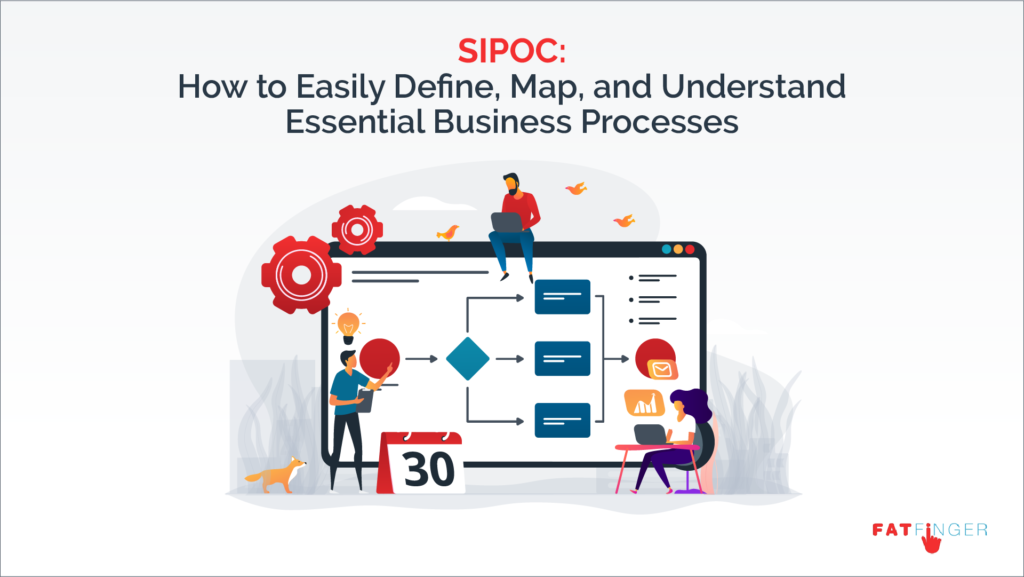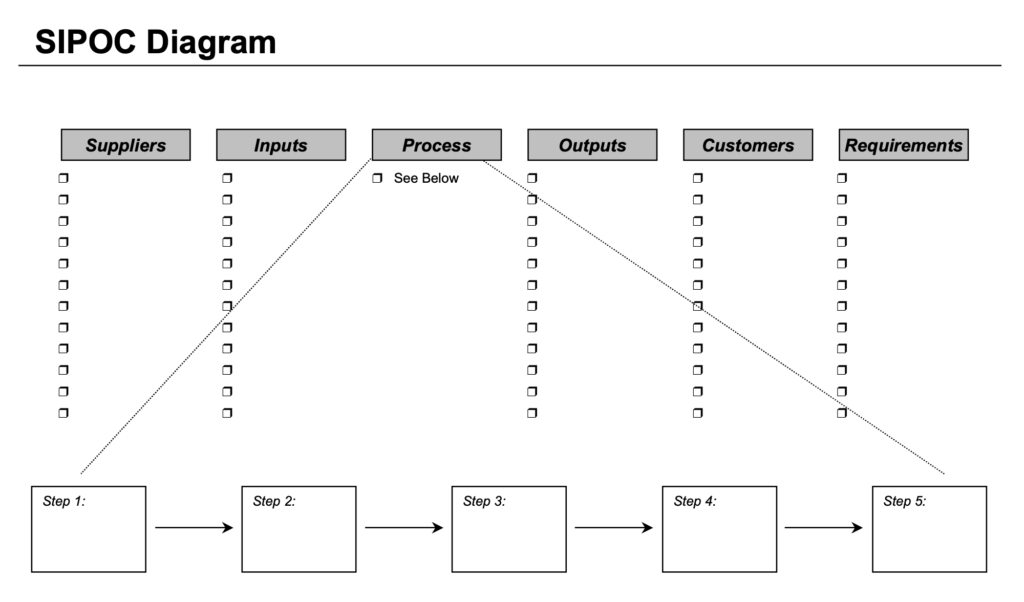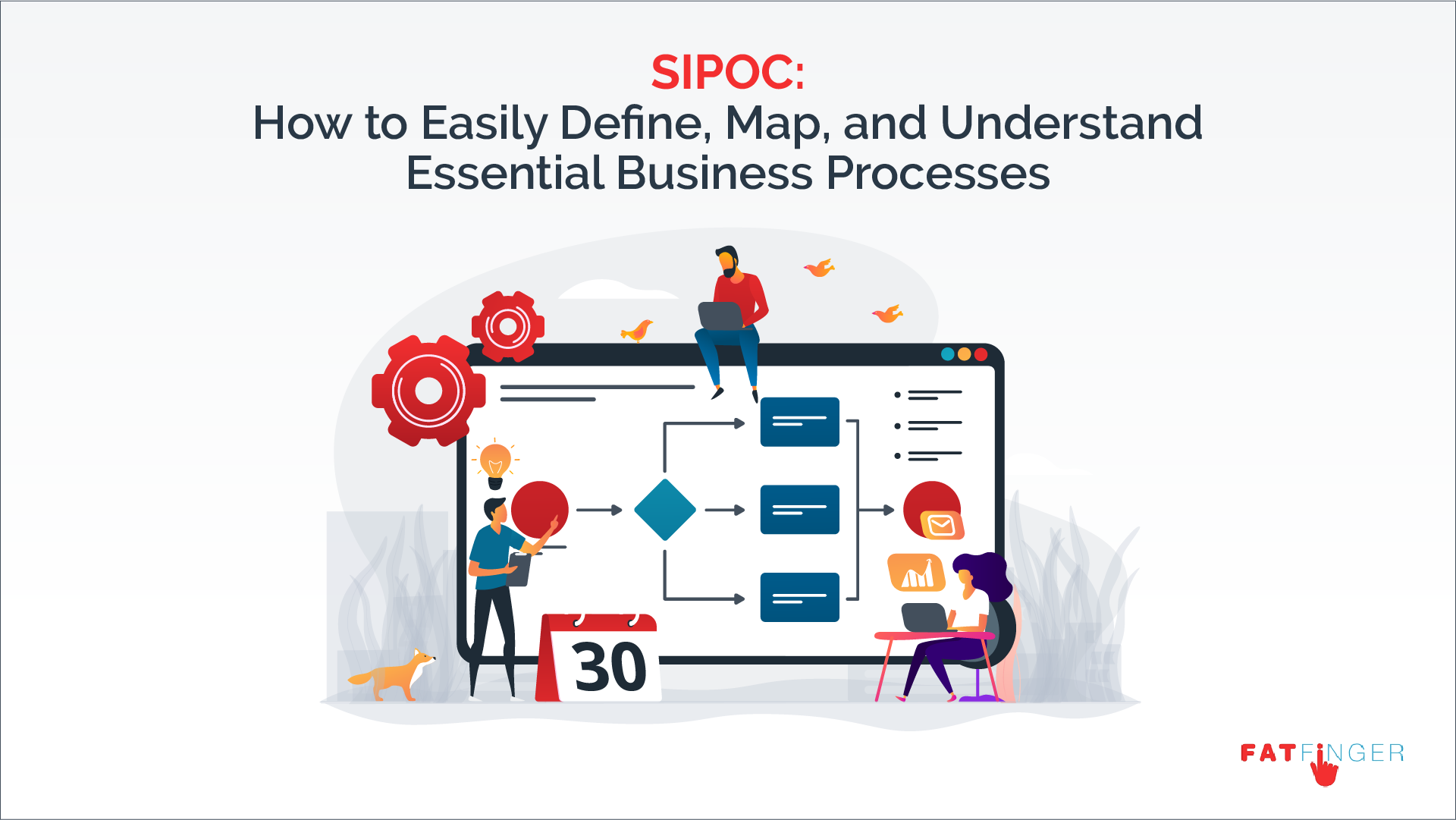
Today, there won’t be the usual FAT FINGER post introduction, filled with personal stories, pop culture references, and jaw-dropping anecdotes.
Instead, I’m cutting right to the chase, dealing with the things that can very well make or break a business, no matter how well-invested, well-connected, and well-staffed it is.
You guessed it: I’m talking about business processes. After all, it’s effective business processes that allow you to complete tasks to a high quality. It’s efficient business processes that allow you to operate faster than your competitors. And it’s easy-to-follow processes that keep everyone on the same page, no matter if they’re newly-hired employees or company staples.
But how do you know your business processes are working? And that the things you’re trying to bolster your processes with are working, too?
According to research undertaken by the BPM maestros Paul Harmon and Jorge Garcia, a concerning 20% of people don’t know if their process technologies and practices are helping to improve their processes.
At FAT FINGER — providers of agile workflow software — we say there should be no doubt whatsoever that the process-orientated tech (like ours!) and practices you deploy are having a direct, positive impact.
That’s why I’m going to tell you about SIPOC, a simple tool for processes that’ll enable you to easily define, map, and understand your essential business processes.
Specifically, I’ll define what SIPOC is, explain how everyone can create their own SIPOC diagram from scratch, and go over the benefits of creating SIPOC diagrams in the first place.
All you need to do is read the following sections:
- What is SIPOC?
- How to make a SIPOC diagram from scratch (with examples)
- The benefits of a SIPOC diagram
- Use FAT FINGER to define AND take action on business processes
The quicker you know about SIPOC, the better — let’s get started!
What is SIPOC?

SIPOC (which stands for ‘suppliers,’ ‘inputs,’ ‘process,’ ‘outputs,’ and ‘customers’) is a process improvement tool that allows people to document their business processes. SIPOC is primarily used in conjunction with Six Sigma, business process management, and lean manufacturing principles (such as DMAIC), but it can also be used in a standalone manner.
SIPOC isn’t some new-fangled business concoction; it dates back to the 1980s, when it was first used in total quality management programs. You may have also heard of SIPOC being referred to as ‘COPIS,’ where the ‘customers’ part is put at the front. Customer-centric organizations will use this alternative — which is SIPOC reversed — so they can define who the customers are in any given process first.
That’s the contextual information part over.
But what actually is SIPOC? How can one do SIPOC?
SIPOC takes the form of a digitally or physically drawn diagram. Specifically, the diagram is a table with 5 columns. The words ‘suppliers,’ ‘inputs,’ ‘process,’ ‘outputs,’ and ‘customers’ appear at the top of each column. Then, inside the columns, you write down answers that correlate with the column and the process you’re looking at.
So, for instance, if you’re going down the COPIS route and your COPIS diagram concerns the process of a car repair, you’ll write down the customers in the ‘customer’ column, which will be the vehicle owner, a customer service representative if the vehicle owner was in contact with one, and the mechanic (the latter two are customers themselves).
All this is done so you can get a high-level overview of the process in question!
How to make a SIPOC diagram from scratch (with examples)

Think that creating your own SIPOC diagram (or COPIS diagram, for that matter) sounds easy?
That’s because it is — once you know the ins and outs, of course! My short example in the above section gave you a brief overview, but it’s in this section where I’ll get into the nitty-gritty of SIPOC diagrams, guiding you on how to create your very own from scratch.
SIPOC step #1: Choose the process you’re defining
First thing’s first: you’ll need to choose the process you’re defining. Whether it’s a manufacturing process or an ISO auditing process, anything is fair game.
SIPOC step #2: Create the SIPOC diagram’s table
The next step is to draw a table with 5 columns — or, alternatively, you can get a piece of software to do it if you’d rather not use pen and paper. You may want to include small boxes above each column, so you can write ‘suppliers,’ ‘inputs,’ ‘process,’ ‘outputs,’ and ‘customers’ inside. Equally, you can just write these words above the columns without their own boxes.
SIPOC step #3: Label each column
You saw this one coming, I’m sure: write down ‘suppliers,’ ‘inputs,’ ‘process,’ ‘outputs,’ and ‘customers’ above the appropriate columns, so they’re labeled.
At this point, your diagram should look similar to this diagram from isixsigma.com (minus the ‘requirements’ column, which can be appended, but isn’t necessary):

SIPOC step #4: Note down the process you’re tackling
You’ll be creating more than one SIPOC diagram, I assure you. By noting down the name of the process you’re tackling — in big, bold letters above the diagram — you and others will know exactly which process the SIPOC diagram concerns.
If you’re using a piece of software — even if it’s Microsoft Word! — to create your SIPOC diagram, make sure to call the file name something memorable, with the process name as part of the file name.
SIPOC step #5: Define the scope
Defining the scope — i.e. which locations/branches/areas/geographies, etc the process concerns — isn’t strictly necessary, but it’s certainly helpful to do so if you’re a larger company, and especially if you’re operating in multiple locations.
On this note, you may want to write down who was involved in creating and working through the SIPOC diagram, too. This is so if anyone views the SIPOC diagram after the fact and they have a few questions (or suggestions for improving the process), they know who to contact.
Noting down the date somewhere may be useful, as well.
SIPOC step #6: Identify the suppliers
Now it’s time to start filling in the table. This means, firstly, identifying the suppliers of the process. Ask yourself the question: who supplies the materials/inputs?
For instance, when it comes to the process of a coffee shop making coffee for a customer, the suppliers are:
- The customer (who told the barista what they wanted)
- The barista (who, with their coffee-making know-how, can make the cup of joe that the customer wants)
- The coffee shop owner (who has supplied the shop with the necessary materials for making coffee)
Once you’ve figured out who the suppliers of your process are, write them down in the designated ‘suppliers’ column. Use bullet points for succinctness and clarity.
SIPOC step #7: Confirm the inputs
Next up, you’ll want to confirm the inputs of the process. This, in layman’s terms, means asking yourself: what resources are needed to complete the process?
Going back to the coffee shop example, to make a cup of coffee for the customers, the myriad of items/inputs will include:
- Information concerning what kind of coffee the customer wants
- The customer’s money for the coffee
- A transaction receipt
- The materials to make the coffee — a press, grinder, etc
- The ingredients to make the coffee — coffee beans, milk/non-dairy products, etc
- A takeaway cup/in-house coffee mug
Again, once you’ve found out what the inputs are, write them down in the appropriate ‘inputs’ column.
SIPOC step #8: List the steps of the process
The third step — which marks the halfway point — concerns listing the steps of the process, which is arguably the most important step of SIPOC. Essentially, you’ll want to ask yourself: what steps need to be taken to complete the process?
For a coffee shop making coffee for a customer, the process will look a little like this:
- Receiving the coffee order
- Completing the financial transaction
- Providing the customer with a receipt
- Preparing the coffee
- Making the coffee
- Pouring the coffee into the appropriate container
- Giving the customer the coffee they ordered
If you’re creating a SIPOC diagram for a process that you’re familiar with, this step will be a breeze. If you’re defining a new process however, don’t worry if it takes you a tad longer than you thought it would!
SIPOC step #9: Confirm the outputs
Just as you confirmed the inputs two steps ago, you’ll now need to confirm the outputs. It’s here where you’ll want to ask yourself: what have the inputs and the process led to? What products/services have been created?
After undergoing the coffee-making process, the outputs will be:
- A completed transaction
- A completed coffee order
- A steaming hot cup of joe
- A happy customer who has had their caffeine fix
- Potentially a good review on Yelp or Facebook, or even a tip!
List the specific outputs concerning your process in the ‘outputs’ column.
SIPOC step #10: Write down the customers
Last but by no means least, the final step of creating your SIPOC diagram is writing down who the customers are. It’s important to note here that, customers, in this instance, aren’t just the people receiving the product/service. They’re all the people who benefit from the process in question.
So, to go back to our trusty coffee shop use case, the customers will be:
- The customer who received the coffee
- The barista (because by making coffee, they’re earning $$)
- And the coffee shop owner (as they’re profiting from the custom)
This column requires you to think outside the box a little, broadening your definition of who a customer is, exactly. But over time, you’ll get more and more used to it — just like everything else in life!
SIPOC step #11: Make use of your finished SIPOC diagram
With a completed SIPOC diagram filled with useful, relevant information right at your fingertips, the only thing that’s left for you to do is, well, make use of it!
“Making use of it” means different things for different people, though.
If it was your goal to simply define a new process, or to document it so you had it on file, then you’ve achieved your aim. Perhaps you’ll want to take things one step further by transferring the process to a tool like FAT FINGER, where you can then action on the process.
Or, perhaps you wanted to use SIPOC to help you with process improvement. If that’s the case, investigate your findings. Are the process steps you’ve defined in the ‘process’ column actually being followed on the floor — have you noticed that employees are skipping integral steps, for instance? Are the materials you’ve listed in the ‘inputs’ column readily available to employees? For SIPOC to truly help you with process improvement, you’ll want to combine your SIPOC diagram with Six Sigma and lean methodologies, such as DMAIC.
How you choose to use your SIPOC diagram, then, is ultimately down to you. What’s most important is knowing how to create one yourself.
The benefits of a SIPOC diagram

A lot of things didn’t make it out of the 80s — like hair crimping, suits with shoulder pads, and parachute pants.
SIPOC, however, did.
Considering its longevity, that means SIPOC must still be beneficial for modern-day companies, correct?
Correct.
- With SIPOC, you’re providing a comprehensive, no-nonsense overview of an integral process. At its core, SIPOC is all about mapping out a process, helping you and your team to define how it functions, and helping everyone to understand the process in question better. SIPOC, then, makes what could be complicated and confusing anything but. What’s more is that, once a process has been mapped and defined with SIPOC, if the diagram is put in an accessible place for employees (like on the company intranet, or even on a Notion page), they’re all able to get to grips with processes, whether new or old. Speaking of which…
- You’re helping new hires get up to speed with internal processes. Here’s a question for you: have you ever, at some point in your career, started a new role and been asked to complete a certain task, but had no idea how to go about it? I have. It’s a daunting prospect, and it’ll fill a new hire with dread and anxiety — unless there’s a way for them to quickly get up to speed with a process, which SIPOC certainly provides.
- You’re establishing a process-centric culture. All companies have and follow processes. But not all companies have a process-centric culture. By ‘process-centric culture,’ I mean an environment where employees are cognizant of their business’s processes, how they function, and how they can even be bettered. Having a process-centric culture equals improved processes, and improved processes equals a better business overall.
- You’re beginning a journey of process improvement and optimization. SIPOC can help you improve and thus optimize processes. If process improvement and optimization is a new area for you, then SIPOC allows you to gently get acquainted with it. Once you realize how easy it is to do SIPOC — and once you see all the benefits come to fruition yourself — you’ll surely be raring to get started with more in-depth and thorough methods for process improvement and optimization.
- You’re encouraging team-wide collaboration. Just like Kaizen Events, it’s recommended that, when a small group of employees gets together to undergo SIPOC, there’s a mixture of employee seniority. For instance, let’s say the process that’s about to undergo SIPOC is an onboarding process for new employees. Having a junior recruiter, who has front-line knowledge of how the business goes about onboarding, is just as useful as having a senior recruiter who has helped build the process in the first place, as you’re bringing both of their perspectives together. Here’s to properly collaborating as a team.
As mentioned earlier, while undergoing and completing SIPOC — and coming out of it with a SIPOC diagram — is a feat to celebrate, you’ll want to take things one step further if you’re truly interested in developing how your business goes about its processes.
Specifically, you’ll want to take things one step further with process-orientated tech, like FAT FINGER.
Use FAT FINGER to define AND take action on business processes
FAT FINGER enables teams to digitize their essential processes, procedures, and workflows with one simple tool.
Once digitized via our tool’s apps (aka digital checklists), your team members can tackle processes with utmost precision, as the apps will guide them on what to do and how. Every step of the way.
And, in case you were wondering, we’ve built FAT FINGER with non-technological people in mind, meaning it’s super easy to use, no matter how tech-savvy you may or may not be!
Here’s an overview of how FAT FINGER works.
When it comes to SIPOC, think of FAT FINGER as the next logical step once you’ve created your SIPOC diagram.
You can transfer all the process steps over to a FAT FINGER app. That app can then be used each time an employee needs to complete that specific process. No matter if they launch the app early on a Monday morning or during the late hours of a Friday night, they’ll do exceptional, high quality work, as the process steps stipulated in the app will guide them from beginning to end.
FAT FINGER, then, enables you to take action on business processes in a way that a diagram alone can’t!
In addition to our incredibly useful apps, there are a plethora of other fantastic features in FAT FINGER, like assignment features, notification features, authorization features, real-time dashboard reporting, even an AI coach — and much more.
Want to try FAT FINGER for free?
The video below, featuring FAT FINGER’s CEO James McDonough, walks you through a handful of FAT FINGER best practices. It’s a must-watch.
With SIPOC and FAT FINGER covered in great detail, all that’s left for you to do now is to define and take action on your business processes.


